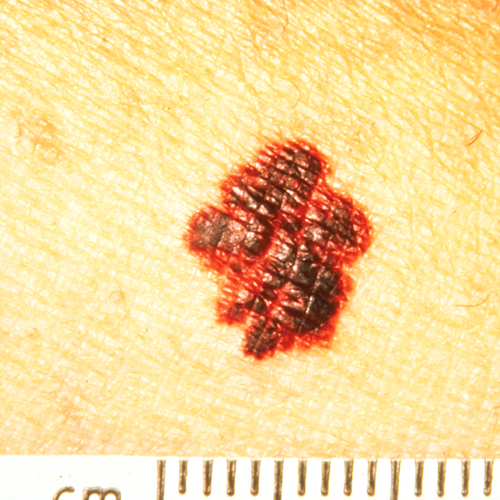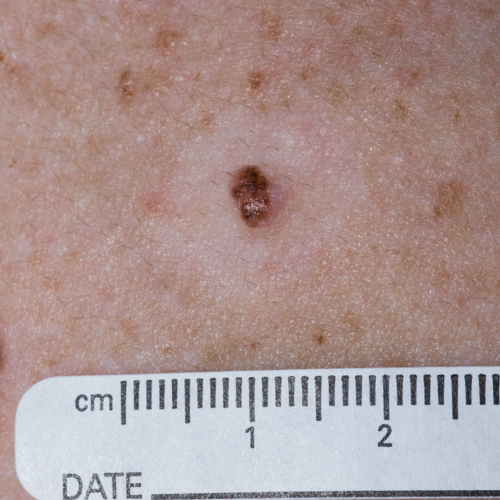What Is Melanoma?
Reviewed by: HU Medical Review Board | Last reviewed: May 2017. | Last updated: April 2023
Melanoma is a type of cancer that develops from melanocytes, the cells that give skin a tan or brown color. There are about 87,000 cases of melanoma each year. It is far less common than non-melanoma skin cancer.1
Melanomas can develop on parts of the body that get frequent sun exposure: chest, back, legs, face, ears, and arms. It also can grow in areas that do not get much sun, such as palms, soles of the feet, fingernails, and toenails (known as subungual melanoma).2,3 Melanoma is more likely than non-melanoma skin cancer to invade deeper layers of skin and spread to other body parts.
Melanoma is most common in fair-skinned individuals. However, people with darker skin tones can develop melanoma too. Other risk factors are: family history of melanoma, a medical condition called xeroderma pigmentosum, or having multiple atypical moles. Certain infections or medications that weaken your immune system may also increase your risk of melanoma.3
The four major types of melanoma are:
- Superficial spreading melanoma
- Nodular melanoma
- Lentigo maligna melanoma
- Acral lentiginous melanoma
Can melanoma be cured?
If caught early, most melanomas can be treated and removed with surgery.3 In 84% of cases, melanoma is diagnosed before it has spread.4 The term for this is “localized disease.” The survival rate 5 years after diagnosis of local melanoma is 98.4%.4
It is harder to treat melanoma that has started to spread. The term for cancer that has spread from the original tumor to other parts of the body is metastasis. Melanoma cancer cells travel through the body via the lymphatic system. Your doctor will do a skin biopsy to diagnose melanoma. Then she or he will check nearby lymph nodes to see if the cancer has spread.3 In about 9% of cases, the nearby lymph nodes have cancer cells.4 The term for this is “regional disease.” The 5-year survival rate for regional melanoma is 62.4%.4
A “distant metastasis” is cancer that has spread from the original tumor to a distant part of the body. Only 4% of melanoma is diagnosed at this late stage.4 The 5-year survival rate for distant metastatic melanoma is 17.9%.4
Once you have had one incidence of melanoma, your risk of another one goes up. Your doctor will advise you on how often to follow up.
What does melanoma look like?
Most melanomas are brown, black, or blue (“pigmented”) lesions.2,5 Some tumors are pink, red, tan, or white. Typically, melanomas are larger than normal moles and have an unusual shape and color.
Doctors and patients can use the ABCDE memory aid to identify possible melanomas:2,5
- Asymmetry
- Border irregularity
- Color variation/unevenness
- Diameter of 6 mm or more
- Evolution or changes in the mole
What are the treatments for melanoma?
The goal of treating melanoma is to remove the tumor and kill any additional cancer cells that may cause the cancer to return (recur) or spread. Treatment is chosen based on cancer stage.
The first choice of treatment for melanoma is to remove (excise) the tumor.2,3 The name of this procedure is “wide excision.” The surgeon removes the entire tumor. The surgeon also takes some of the healthy skin surrounding the tumor, called the “margin.” This is done to remove any melanoma cells that have spread into the tissue surrounding the tumor. It may reduce the chance of recurrence. The margin width depends on the size and location of the tumor. Big melanomas generally have wider margins than small melanomas.
If the melanoma tumor is thick, your doctor might suggest a sentinel lymph node biopsy, even if you have no lymph node symptoms.2,3 A special dye is injected near the melanoma tumor. The dye travels in the lymph. The doctor can see which lymph node it reaches first. This is the “sentinel lymph node.” Your doctor will take a small tissue sample (biopsy) and check it for cancer cells. If the cancer has spread to the sentinel lymph node, your doctor may recommend removing the lymph node. Your doctor might also recommend medications that help your body fight any remaining cancer cells. Radiation therapy is sometimes used to treat the area where the lymph nodes were. Radiation therapy kills cancer cells that remain. Additional tests will be done to see whether cancer has spread further.
Options for advanced melanoma include targeted therapy or chemotherapy to kill the cancer cells. Surgery may help to control metastatic cancer, but does not usually cure it.
How can I prevent melanoma?
Ultraviolet (UV) light exposure is the most important modifiable risk factor for skin cancer. Melanoma has been linked to frequent sunburns, especially during childhood and especially in men.3,6 Intermittent, intense sun exposure—such as a summer day at the beach—is a risk factor for melanoma.
You can protect yourself from the sun and reduce your UV exposure. Precautions include:
- Using a broad-spectrum sunscreen with sun protection factor (SPF) 15 or higher.
- Seeking shade between 10 am and 2 pm.
- Wearing long sleeves, long pants, wide-brimmed hats, and sunglasses.
- Avoiding indoor tanning beds.
Some risk factors are things you cannot change. These include:3
- Having dysplastic nevus syndrome
- Having a close blood relative who has had melanoma
- Having more than 50 normal moles or having 5 or more atypical moles
If you have multiple risk factors for melanoma, your doctor may recommend regular skin exams with a health care provider.











